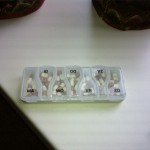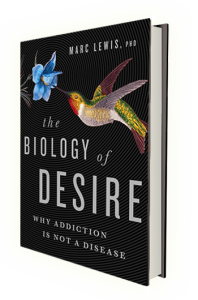You know, there’s this little device invented to help organize people’s pill popping. It’s a plastic oblong container divided into seven units, one labelled for each day of the week. A certain number of each kind of pill goes in each compartment, according  to a preordained plan, of course. It looks like this. At least it does in the Netherlands, where we go Mondag, Diensdag, Woensdag, and so forth.
to a preordained plan, of course. It looks like this. At least it does in the Netherlands, where we go Mondag, Diensdag, Woensdag, and so forth.
All I need right now is painkillers, i.e., opiates (which I like) and muscle relaxants, i.e., benzos (which I hate). My neck still hurts about three times more since the surgery than before. It’s a Christian country, the Netherlands, so maybe they perform surgery in order to maximize pain now, in order to minimize the bill you’re going to be presented with when you die. I think that’s called penance. But probably it’s not that complicated. Bodies don’t like being sliced and diced and they register their dissatisfaction in the clearest possible terms.
So painkillers it is. And what’s to prevent me from taking an extra one or two today, and ending up a couple shy later in the week? The answer is self-programming. And that’s what the little box helps me to do.
I wrote a post on self-programming a few months ago. Here it is. The reason I bring it back up now is because I think it’s such a brilliant idea. Our brains are built in such a way that we are highly attracted to immediate rewards — pleasures, relief of various sorts, winning an argument at the expense of someone else’s self-esteem, or at the expense of the guilt you’re  going to feel when you think about what a shitty, selfish thing that was to say. In general, present wants, needs, urges thoroughly trump wants and needs that can’t be cashed in till later. But the kicker is that we think we’re in the driver’s seat. We think our present actions are actually generated by the conscious intentions that preceded them. Psychological and neuroscientific research is pretty clear: they’re not. They’re mostly generated by habit, context (including cues), and biased thinking. So we keep up this mythology about deliberate intentions while coming in for a landing based on factors beyond our control. This common human dilemma is nowhere as clearly demonstrated as in addiction.
going to feel when you think about what a shitty, selfish thing that was to say. In general, present wants, needs, urges thoroughly trump wants and needs that can’t be cashed in till later. But the kicker is that we think we’re in the driver’s seat. We think our present actions are actually generated by the conscious intentions that preceded them. Psychological and neuroscientific research is pretty clear: they’re not. They’re mostly generated by habit, context (including cues), and biased thinking. So we keep up this mythology about deliberate intentions while coming in for a landing based on factors beyond our control. This common human dilemma is nowhere as clearly demonstrated as in addiction.
The solution: self-programming. The prefrontal cortex and it’s good buddy, the anterior cingulate, are beautifully designed for self-programming. That’s why these brain parts evolved over the last few  hundred million years. So that we don’t just act on impulse; we create plans in advance that will filter, constrain, and otherwise improve our behaviour so that it isn’t just driven by impulse. Long-range planning works pretty well. Short-range planning is usually a sham, a rationale, for what you’re in the process of doing anyway.
hundred million years. So that we don’t just act on impulse; we create plans in advance that will filter, constrain, and otherwise improve our behaviour so that it isn’t just driven by impulse. Long-range planning works pretty well. Short-range planning is usually a sham, a rationale, for what you’re in the process of doing anyway.
So here’s this dandy little device that not only facilitates long-rage planning but actually helps us learn it — a critical skill for those prone to addiction. Simply a box containing compartments that tell you what you may do (take) and what you may not do (take) based on long-range reasoning. I love it! And do you remember the post in which I reported on research showing that regions of the anterior cingulate cortex increase in grey matter volume (synaptic density — probably a good thing in these regions, especially since it got eroded during all those years of using) after you quit? In fact, GM volume rises in a pretty straight line over months of abstinence, crossing the baseline estimate at about 9-10 months. Here’s the source article. The authors conclude “that recovery involves distinct neurobiological processes rather than being a reversal of disease-related changes. Specifically, the results suggest that regions critical to behavioral control may be important to prolonged, successful, abstinence.” I’d be willing to bet that the regions showing increased grey matter volume are where the neural basis of self-programming is strengthened — through practice!
Of course, for many of us ex-addicts, many of those compartments, maybe all of those compartments, contain a big fat zero. (I mean for people on a full-abstinence program). But it’s not really a zero, because you fill up the compartments with other stuff. Is Friday night going to be a difficult time, being at a party with a glass of iced tea in your hand? Well then you fill that compartment with two hours of your currently favorite mini-series, or a visit to a dear friend, or a chapter from a book you love. And you leave early to get your dose. It’s your reward, decided on in advance. So you don’t have to think about what you will or won’t do on that  particular evening. It’s already programmed. You programmed it three weeks ago when you got the invitation. And now you’re free to enjoy or at least endure the party. You have a nicely evolved cortex and you’ve learned to use it well. Keep learning.
particular evening. It’s already programmed. You programmed it three weeks ago when you got the invitation. And now you’re free to enjoy or at least endure the party. You have a nicely evolved cortex and you’ve learned to use it well. Keep learning.
Here are a couple of Buddhistic-type figures smiling down on my new self-programming aid. They recognize that good planning is the route to nirvana.
 Informed by unparalleled neuroscientific insight and written with his usual flare, Marc Lewis’s The Biology of Desire effectively refutes the medical view of addiction as a brain disease. A bracing and informative corrective to the muddle that now characterizes public and professional discourse on this topic.” —Gabor Maté, M.D., author of In The Realm of Hungry Ghosts: Close Encounters With Addiction
Informed by unparalleled neuroscientific insight and written with his usual flare, Marc Lewis’s The Biology of Desire effectively refutes the medical view of addiction as a brain disease. A bracing and informative corrective to the muddle that now characterizes public and professional discourse on this topic.” —Gabor Maté, M.D., author of In The Realm of Hungry Ghosts: Close Encounters With Addiction
I’m intrigued! I presume (you know what happens when you assume) that when you say “a box containing compartments that tell you what you may do (take) and what you may not do (take) based on long-range reasoning” you don’t literally mean a box when you’re talking things you may do. Seems like an awesome app though!
No no! It’s just a plastic container, not an app. Look at the picture. No doubt your mom or your grandmother has one just like it. It’s mostly used by older people who forget whether or not they’ve taken this or that pill on a given day. And I’m just saying that any device — even a simple plastic box — that helps us organize our behavior IN ADVANCE is doing the work — “scaffolding” if you like — that is embodied in the phrase “self-programming”.
We (humans) do this all the time. It’s just that we’re rarely aware of it. Have you started planning your summer vacation yet? Self-programming is an obvious tool when we’re dealing with reservations, rentals, hell, even getting married — and that’s when we become aware of it. I’m saying: BE AWARE of it as a tool to help combat addictive impulses. It’s really helpful!
I get that you were talking about a plastic container in terms of allocating your pain medication. I just wasn’t clear that you also meant to literally put a piece of paper with “two hours of your currently favorite mini-series” or “a visit to a dear friend” in a physical slot for the Friday you’re going to a difficult party (for example). IMO, that doesn’t need to be in the plastic box … that could be in the app equivalent of a plastic box!
Oh, I see. Perhaps I was stretching the analogy. But I didn’t mean to suggest that you need to put notes in the compartments. Any way you can concretely plan future choices before they’re upon you would be helpful. I guess the key point is the “concreteness”. We often use implements of one kind or another to enhance or stabilize our skills: anything from a knife and fork to a lawnmower, or from a pen and paper to a computer keyboard.
Come to think of it, a note (penned on a blank sheet of paper) was what helped me quit at the age of thirty. The note simply said “No” and I hung it on my wall. That was self-programming. Anything concrete takes some of the burden off, so you don’t have that extra slack in your thoughts and fantasies — slack that can so easily be used to change your mind for what seem like excellent reasons. The “one last time” syndrome” or “because I had a particularly rotten week” — whatever it is.
This time the pillbox fulfilled that function. It left little room to even pretend to have a good reason for changing the plan…and I think that’s key to many (ex)addicts in their efforts to get or stay clean.
Interesting that we use this, and I used this, as a tool in recovery. I had a piece of paper which listed all the activities I needed to do in a day, from getting up to eating! I then had a list of activities that I liked to do, such as reading, walking etc. I ticked off each activity as I did it and when faced with some time of boredom immediately looked at my list and did one of the other activities.
The advantage was that I pre-planned my time. This was a massive advantage because my decision making was pre-done, I made my decisions/choices distally not proximally!
Interestingly, I found this much more effective than having a diary with time slots, because as soon as I had missed a particular time-slot, my whole plan was thrown into disarray, so what the heck, may as well use!
By just having this pre-thought out list (which I made while high as a kite!) I still had the impression of proximal decision making – that edgy seat-of-my-pants kind of thing that made me feel free, but my focus was greatly narrowed by the choices on the paper!
Just my experience which may align with some of your thoughts.
I like this.
I remember those little boxes with their different colors and configurations. I used to shop for them with the same deliberation I used to buy a new pen, if not the same enthusiasm. But all the different boxes were of no help when I was driven to break into a steel lock box with a crowbar to get my prescription. It was mine goddamit. It had my fucking name on it.
I think the best laid plans go awry when the addiction not only thwarts our intention, it becomes our intention. And the little buddhas on your window sill would tell you that no pill box in the world will work if its use doesn’t arise from pure intention, meaning an intention that is not mixed with other plans or influences—“this will convince my wife that things are getting better!” or “It’s not a problem to take one early if I’m in pain because I can see how many are left!” Not saying this is your case—just saying that it was my experience with the SMTWTFS. (And remember, after Tuesday, even your pill box says WTF.)
If it weren’t for pain, we wouldn’t be able to learn as much as we can as humans. That box can be a useful tool now, because you want it to be— to avoid further pain.
I think the little buddhas would tell us that good planning is the way, but only if our intention and motivation are solid. And sometimes that’s not easy to know.
Yes. Matt, all this comes from something I was thinking a lot about back in October and which I tried to express in a post then: https://www.memoirsofanaddictedbrain.com/connect/self-programming-how-choice-actually-works/
It’s a way to try to grapple with the issue of willpower, and its structure is no different than putting away half the chocolate cake before serving dessert. Yes, the motivation and intention must be solid, but we have to be smart enough to realize that the closer we get to the moment of choice, the less impact our conscious intentions will have on our behaviour. This relates to all those experiments, starting with Libet ‘s work in the 80s, showing that your brain is about two seconds ahead of your conscious mind, so to speak, whenever you make a “free” choice. Check out this little film clip: http://www.youtube.com/watch?v=IQ4nwTTmcgs&feature=kp The point is that immediate intentions are eclipsed by behavioural habits or impulses that are already in action. You think you’re in control of yourself but you’re not.
I borrowed the phrase “self-programming” from Marc Slors, a philosopher here in the Netherlands. He arrived at the simple conclusion that the best way to connect intentions with actions relies on DISTAL intentions — those that can be formulated days or weeks in advance, for example. Self-programming is simply a way to capture those intentions, concretize them, and program them into your life in a way that’s not easy to override by the impulses that take over in the moment.
This principle is used by CBT recovery approaches to develop strategies ahead of time for upcoming events that may contain triggering situations, like a wedding where someone is likely to put a drink in your hand if it’s empty. Is this a type of reinforcement for the distal intention of not drinking? I suppose this is why time is such a crucial factor in recovery. You need time to formulate and concretize the superordinate intention of remaining sober to override any proximal, impulsive intentions. It takes practice. I’m curious about how anti-craving drugs like Campral and naltrexone’s inhibitory effects affect brain chemistry to facilitate this. Or not. (my case: a long established using behavior) Do you, Slors or anyone else have recommendations for how to do this more efficiently(like mental calisthenics), reducing the time factor, and getting people into a more effective recovery much sooner? To accelerate the self-programming?
Matt, I just wrote a LONG response to this…and then deleted it accidentally. Don’t have the chutzpah to do it again. Highlights:
The pillbox analogy may not work for alcoholics at weddings, but you could make it a rule to keep your glass full — of lemonade or soda.
Re training. We could work backwards from the brain parts that show increased GM density with months of abstinence. The dorsal anterior cingulate seems to show the most growth. And this area is considered responsible for error monitoring, conflict monitoring, etc. No reason these cognitive skills couldn’t be trained rather than just tested.
See joystick experiments in “attention bias modification” literature. Addicts learn to choose the “dry” choice until it becomes habitual, by pushing the joystick away from images of drugs, booze etc. Seems to work too. Nifty idea.
Ok, better click “post”.
Oh and yes, sure it’s similar to some CBT strategies. In fact it plays into a lot of approaches, just maybe not by that name.
The having-your-hand-filled-with-a-drink is a common strategy we use in SMART, because there is so much worry around social gatherings where alcohol is served early on.
So it is cool they have these joystick “drills” to help people habituate the new behavior. It would be helpful for them to be customizable, because situational or mood governed factors come into play as triggering conditions. For example, a woman whose problem was pills: getting over on her doctor, or the opportunity to pilfer pills was the trigger that set things into motion. The “sneakiness,” that she deserved this, and this was the way for her to get her space, to control her mood, was both the trigger and the “high”. Or another person who shared that he realized he was really addicted to the chaos that using caused, as both the trigger and actual high. People get to these realizations in meetings, but it takes weeks to months to discover them.
Are there ways to determine and/or train to the situational specificity of individual triggers? Like stimuli that depict chaotic events or pilfering from a medicine cabinet? I’m spitballing here…somebody help me out?
Matt
I think you might want to look into “Process Addiction” , I know lots of folks who are just as addicted to “Scoring ” as they are to the “doing” of drugs , sex , shopping , yadda , yadda . I’m thinking Marc has explained that in earlier postds .
It’s a good point. Many long-term addicts start getting the buzz when they’re in the process of scoring. Dopamine responds to reward likelihood and reward proximity both. If likelihood increases from low to medium-high, or the reward gets closer in time, the dopamine will start to flow or will increase its flow to the striatum.
Marc,
Those boxes, I had tried them over the time I had copious amounts of painkillers especially in times of “weaning” down. Never worked for me. But I think thats because I ALWAYS started on Wednesday.
Al
Monday is working for me.
Hi Marc,
Those are good points. And let’s state the ‘meta’ point here.
There are a number of methods of taking and implementing a
‘longer view’ of things. Going to one’s support meeting every
Wednesday at 7 pm. There are practical steps such as
“Do not have large bottle of booze/pills, etc. lying around.”
There are ‘check in’ strategies.
All of these ‘meta’ strategies depend on some ‘meta’ parts of
us, based ultimately in our brains.
All of them, as “Al” points out, are easily circumvented. They
depend, so to say, on the health of the ‘meta’ part. Your ability
to make a “NO” poster and to abide by it. IF we were to assume
NO meta-capability, that it was as corrupted as your other areas,
the procedure would not work, just as the pill containers would
not work.
To the extent that some part of a person is healthy, either he or a
therapist/counsellor can ‘ally’ with it, make implementing plans, etc.
I see your point, NN, but there’s a very basic level of cleverness involved. If my Christmas vacation involves either a trip to Cuba or one to Florida, and I’d really like to try out Cuba this time, but I’m feeling leery about it, then I might buy a ticket well in advance. A non-refundable one! That increases the difficulty of changing my mind later on. If I go on to rent a car and put down the money, then I’ve further cemented my intentional action. All you’re really doing is changing reinforcement contingencies — increasing the negative reinforcement for a self-indulgent (or chicken-shit) lapse.
You’re both the researcher and the rat in the Skinner box. That’s the beauty of it.
I am certain these will work fine if a family member or sober friend has control of the medication organizer. Any self respecting addict will gobble them all up right away – schedule be damned ! ! ! Why are you still on pain meds, anyway?
I know. But I’m no longer a self-respecting addict. That was a long time ago. What I’m trying to get across is that “self-programming” is a universal tool for bridging your intentions with your actions. This can only be done with “distal” intentions (intentions that surface long before the anticipated moments of choice), since “proximal” intentions get sucked into the vortex you refer to….and this “wisdom” can apply to anyone at any stage.
Why pain meds?
“Some patients require narcotic medications for up to a few weeks after surgery. These medications should be weaned as pain diminishes.”
(http://www.understandspinesurgery.com/Articles/Read/Understanding-Rehabilitation-and-Care-Following-Anterior-Cervical-Fusion)
That’s just what I’m doing. It’s been two weeks, and I’m weaning…
Hi Marc..
Sorry about your neck…I just went thru a shot series for Stenosis, kyphoscoliosis (I looked like Quasimodo in my daughters wedding pix),disc disintegration and osteo arthritis. Growing old is not for wimps except I have been growing old since I was 11 and had the MRSA attack. As a result I FEEL YOUR PAIN!!
Oddly enough, I have been using those little trays for years.Not sure they help but with my brain condition I have to take 4 different meds during the day.
So many receptors have been blown out that a med that only affects one or two (like SSRI’s) don’t cut it.
Now here is the odd part…being an alcoholic I can TELL the difference between addiction and medicating. And some of the pills I take would make your average AA veteran hair turn white. BUT I don’t get addicted. How do I know? Because I forget to to take them at times and am able to completely quit when necessary, without a lot of problems like alcohol.
That is why I am convinced that taking an SSRI (Lexapro in my case) while partying up a storm DOES lead to alcoholism in many cases. Other drugs just don’t have the same effect. And I am not talking pussy drugs either…I have been through adderol, Oxy etc quit them all without problems…..well I must admit there was a teeny bit of discomfort going off Oxy a oouple years ago. It was WAY too strong so I switched to 5/325 Norco.,which hits the same receptors but is not the knockout Oxy is.
Besides I got tired of fighting with Pharamacists who are hyper-sensitive about dishing out that particular drug. Unfortunately T 3’s plug me up for weeks on end….
I have been doing this for YEARS with no increase in consumption…another indicator of lack of addiction.
Also I don’t need to plan unless I am traveling and forget to bring them along.
JLK
Hi JLK. Absolutely, different strokes for different folks. I have no problems with the collection of bottles in the shelf off our kitchen. Booze just doesn’t do that much for me. And I literally can’t have more than three of four without feeling like crap. But I’m sure you don’t have a shelf of bottles off your kitchen. Nor do I have a shelf of opiates.
Self-programming is a therapeutic tool, as far as I’m concerned, to steer you away from what attracts you. Not much attraction, then not much need for it. And it’s true, as other readers have mentioned, that a measly plastic box won’t do much when the intention to get high comes in like a tidal wave over the long-term intention to stay sober. Of course I realize that.
I see the pill-minder as sort of symbolic. When larger measures of self-programming are needed, then you call your doctor and tell him or her that you’re getting addicted. Leave a message at 3 AM if you want. That’s advance planning, and it allows the “good” intention to get in there before the “bad” intention has a chance to shove it aside.
PS. Neck doing much better, thanks. The last 2-3 days: excellent.
Marc, I love your idea of extending the pill box concept out to ways of rationing other behaviors. I can see that being as simple as writing one’s allotted “dose” of whatever on a wall calendar.
And I also agree with several other comments that this sort of tool is no match for a raging addiction. But I know that’s not what you were recommending anyway.
I’ve been playing with self-regulation for a long time, not having things in the house that I know I may binge on on impulse, setting up rules in advance of a situation I think may be challenging. (Though when I was a active bulimic I did a whole lot of planning in the other direction, making sure I had my required supplies on hand for later!)
What’s new and what I love about your idea is that it’s focused not on what you’re abstaining from but what you are prescribing yourself TO do or have! Just like a pillbox was originally designed (I’m guessing) to make sure on TAKES one’s pills, not to stop one from taking too many, I am going to create (in advance) a virtual pillbox with things TO do. The fact that they are intended to replace some less desirable behavior is secondary to needing to be reminded of stuff to do that’s positive. What a creative challenge!
Marc, I’m sending you all kinds of supportive wishes in healing from your surgery and getting off the meds. I also wanted to share that a couple of years ago my brother finally had a (lumbar) spinal fusion surgery after years of living with chronic pain. He confessed to me when telling me about the impending surgery that it was partly because he was tired of being dependent on pain medication which he had been taking pretty much all the time for years. I knew that he had a history of drug addiction in his early twenties (he’s 60-something now) so I was glad to hear he was wanting to stop. As far as I know he’s been doing well as far as back pain goes and isn’t taking any meds any more. Julia
That’s exactly the idea. Self-regulation is indeed something we have to play with, experiment with, throughout our lives. Marriages would not survive without it, and addictions would thrive.
When it comes to eating disorders, there’s no other way. We need to eat so we have to plan our environment to minimize the chances of going down the rabbit hole. And yes, I know the opposite kind of planning too. Good point. I don’t think they’re symmetrical but I want to think about it.
Thanks for your good wishes!